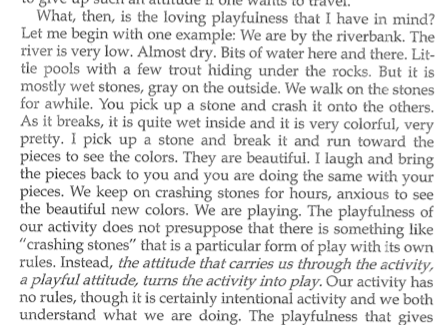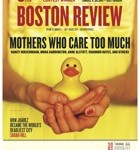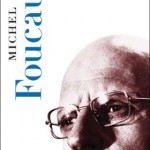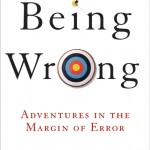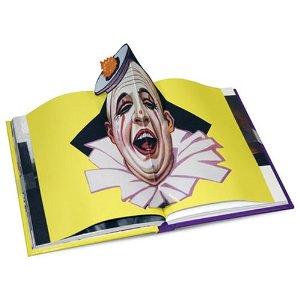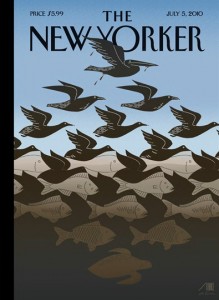 I really like Rebecca Mead’s article about children’s playgrounds in the July 5th issue of The New Yorker: “State of Play: How tot lots became places to build children’s brains.” She describes the history of playgrounds in the U.S. and the shift that is occurring in the philosophy and design of them. Playgrounds used to be designed primarily for regulating children’s behavior, training them to be good (as in disciplined) citizens. With their carefully planned swings, slides, sandboxes and seesaws (the four S’s), playgrounds were intended to give otherwise out-of-control children a place to direct their immense amount of physical energy towards productive, responsible and physically appropriate actions. Now, new playgrounds, like David Rockwell’s Imagination Playground, are being designed to encourage children to be creative and engage in their own imaginative (not-so-directed) play. The 4 S’s are being replaced with loose parts like foam blocks and tubes that can be moved around by kids and put together in expected and unexpected ways. Instead of regulating kids’ unruly behavior, playgrounds are being designed to train kids’ brains so that kids use their imagination more and learn how to creatively explore their own (as opposed to parents’ idea of appropriate) play. Here’s Rebecca Mead’s summary of the change in playground philosophy:
I really like Rebecca Mead’s article about children’s playgrounds in the July 5th issue of The New Yorker: “State of Play: How tot lots became places to build children’s brains.” She describes the history of playgrounds in the U.S. and the shift that is occurring in the philosophy and design of them. Playgrounds used to be designed primarily for regulating children’s behavior, training them to be good (as in disciplined) citizens. With their carefully planned swings, slides, sandboxes and seesaws (the four S’s), playgrounds were intended to give otherwise out-of-control children a place to direct their immense amount of physical energy towards productive, responsible and physically appropriate actions. Now, new playgrounds, like David Rockwell’s Imagination Playground, are being designed to encourage children to be creative and engage in their own imaginative (not-so-directed) play. The 4 S’s are being replaced with loose parts like foam blocks and tubes that can be moved around by kids and put together in expected and unexpected ways. Instead of regulating kids’ unruly behavior, playgrounds are being designed to train kids’ brains so that kids use their imagination more and learn how to creatively explore their own (as opposed to parents’ idea of appropriate) play. Here’s Rebecca Mead’s summary of the change in playground philosophy:
Over the past century, the thinking about playgrounds has evolved from figuring out how play can instill youngsters with discipline to figuring out how play can build brains by fostering creativity and independent thinking. The hope of Rockwell’s playground project is that children who have experimented with fitting together oversized blocks and cogs—and who have learned to navigate a place where social challenges of sharing and collaboration are built into experience—will be better equipped to handle the complexities of twenty-first century life (37).
Sounds great, right? In many ways, yes. I’m all for encouraging kids to be creative and designing playground equipment that fosters their imaginations. I also appreciate the emphasis on play as being driven by kids themselves as opposed to their over-bearing parents. However, I am troubled by how this play is still framed almost exclusively in terms of how it can train kids to be good adults. Whether playgrounds are designed to curb the behaviors and bodies of unruly, troublemaking kids (which Mead indicates were some of the original reasons for developing playgrounds in the early 1900s) or to shape and train their brains to better function in the 21st century (one current playground philosophy), the end goal is always about disciplining children and about “developing [the child’s] abilities, their individual judgment, and their sense of moral and social responsibility” and training them “to become a useful [and productive worker?] member of society” (35).
What’s fun and playful about that? It sounds like more work. Sure I appreciate the shift in emphasis from controlling bad behavior to inspiring creative engagement, but by understanding imagination and creativity primarily in terms of how it trains/disciplines kids to be more creative and able to direct their own actions, a lot of what is fun (and creative) about play is, at best, not valued, and at worst, pushed aside in favor of one version of productive, useful and serious play. In the hyper-competitive, capitalist-driven environment of New York City (where many of these playgrounds are making their debut), these new “imagination” playgrounds could have some contradictory/conflicted results: “achievement-minded New York parents will likely flock to the place” (37), hoping to give their kids’ one more advantage (creative imagination!) for their future in the highly-competitive marketplace. So, play isn’t about playing; it’s about acquiring more tools for success.
Whenever I think about the value of play, I am reminded of Maria Lugones’ wonderful example of playfulness in “Playfulness, World-Traveling and Loving Perception“:
Being playful and playing doesn’t always have to be guided by rules or some larger aim (to be successful at being creative); being playful can (and should) be fun and freeing and not work. Kids know and embrace this. And no matter how hard playground designers, play experts and parents try to shape how they play, kids find ways to have fun on the playground. They use the equipment improperly (by climbing up the outside of the slide) or ignore the equipment altogether (by climbing random trees instead of jungle gyms). Often I have found myself exasperated by my son’s refusal to play on the equipment “properly.” I am sure I have even uttered, “why does he have to make this so difficult–why can’t he play the right way?” (I know, even troublemakers like me reinforce the rules sometimes). While sometimes he is just being difficult, maybe sometimes he is practicing resistance and making trouble for the system and its efforts to mold him into a good little worker. Maybe the playground is full of little-troublemaking revolutionaries? Cool.
SIDENOTE: Almost every time I go to a park I witness how disciplining is done by parents to their own children and to others’ children. Of course, children aren’t the only ones disciplined; parents spend a lot of time at the park disciplining each other (in subtle and not-so-subtle ways). After I started reflecting on these ideas of disciplining and parks, Foucault immediately popped into my head and I knew that if I searched for it, I would find some great articles on Foucault and the playground. I was not disappointed. I can’t wait to read this totally awesome-sounding essay by Holly Blackford entitled “Playground Panopticism : Ring-Around-the-Children, a Pocketful of Women” which I originally found in the journal, Childhood. Doesn’t it sound cool?
In this article, the author invokes Michel Foucault’s analysis of panopticism to understand the performance of mothering in the suburban playground. The mothers in the ring of park benches symbolize the suggestion of surveillance, which Foucault describes as the technology of disciplinary power under liberal ideals of governance. However, the panoptic force of the mothers around the suburban playground becomes a community that gazes at the children only to ultimately gaze at one another, seeing reflected in the children the parenting abilities of one another. The author analyzes the elaborate rules of playground etiquette and social competition that occupy the mothers, linking their social discourses to the public neighborhood playground as a symbol for child-centered (suburban) ideology.
Excellent. I need to read this article and then re-read KCF’s guest blog entry on The Elf on the Shelf.

